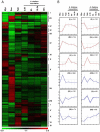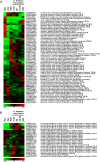Transcriptome dynamics of Arabidopsis thaliana root penetration by the oomycete pathogen Phytophthora parasitica
- PMID: 24974100
- PMCID: PMC4111850
- DOI: 10.1186/1471-2164-15-538
Transcriptome dynamics of Arabidopsis thaliana root penetration by the oomycete pathogen Phytophthora parasitica
Abstract
Background: Oomycetes are a group of filamentous microorganisms that includes both animal and plant pathogens and causes major agricultural losses. Phytophthora species can infect most crops and plants from natural ecosystems. Despite their tremendous economic and ecologic importance, few effective methods exist for limiting the damage caused by these species. New solutions are required, and their development will require improvements in our understanding of the molecular events governing infection by these pathogens. In this study, we characterized the genetic program activated during penetration of the plant by the soil-borne pathogen Phytophthora parasitica.
Results: Using all the P. parasitica sequences available in public databases, we generated a custom oligo-array and performed a transcriptomic analysis of the early events of Arabidopsis thaliana infection. We characterized biological stages, ranging from the appressorium-mediated penetration of the pathogen into the roots to the occurrence of first dead cells in the plant. We identified a series of sequences that were transiently modulated during host penetration. Surprisingly, we observed an overall down regulation of genes encoding proteins involved in lipid and sugar metabolism, and an upregulation of functions controlling the transport of amino acids. We also showed that different groups of genes were expressed by P. parasitica during host penetration and the subsequent necrotrophic phase. Differential expression patterns were particularly marked for cell wall-degrading enzymes and other proteins involved in pathogenicity, including RXLR effectors. By transforming P. parasitica with a transcriptional fusion with GFP, we showed that an RXLR-ecoding gene was expressed in the appressorium and infectious hyphae during infection of the first plant cell.
Conclusion: We have characterized the genetic program activated during the initial invasion of plant cells by P. parasitica. We showed that a specific set of proteins, including effectors, was mobilized for penetration and to facilitate infection. Our detection of the expression of an RXLR encoding gene by the appressorium and infection hyphae highlights a role of this structure in the manipulation of the host cells.
Figures




Similar articles
-
Cellular and molecular characterization of Phytophthora parasitica appressorium-mediated penetration.New Phytol. 2010 Jan;185(1):248-57. doi: 10.1111/j.1469-8137.2009.03048.x. Epub 2009 Oct 6. New Phytol. 2010. PMID: 19807870
-
Production of dsRNA sequences in the host plant is not sufficient to initiate gene silencing in the colonizing oomycete pathogen Phytophthora parasitica.PLoS One. 2011;6(11):e28114. doi: 10.1371/journal.pone.0028114. Epub 2011 Nov 23. PLoS One. 2011. PMID: 22140518 Free PMC article.
-
The Phytophthora parasitica RXLR effector penetration-specific effector 1 favours Arabidopsis thaliana infection by interfering with auxin physiology.New Phytol. 2013 Jul;199(2):476-489. doi: 10.1111/nph.12270. Epub 2013 Apr 17. New Phytol. 2013. PMID: 23594295
-
Phytophthora parasitica: a model oomycete plant pathogen.Mycology. 2014 Jun;5(2):43-51. doi: 10.1080/21501203.2014.917734. Epub 2014 May 19. Mycology. 2014. PMID: 24999436 Free PMC article. Review.
-
Filamentous pathogen effectors interfering with small RNA silencing in plant hosts.Curr Opin Microbiol. 2016 Aug;32:1-6. doi: 10.1016/j.mib.2016.04.003. Epub 2016 Apr 20. Curr Opin Microbiol. 2016. PMID: 27104934 Review.
Cited by
-
Extensin arabinosylation is involved in root response to elicitors and limits oomycete colonization.Ann Bot. 2020 Apr 25;125(5):751-763. doi: 10.1093/aob/mcz068. Ann Bot. 2020. PMID: 31242281 Free PMC article.
-
Gene Expression and Silencing Studies in Phytophthora infestans Reveal Infection-Specific Nutrient Transporters and a Role for the Nitrate Reductase Pathway in Plant Pathogenesis.PLoS Pathog. 2016 Dec 9;12(12):e1006097. doi: 10.1371/journal.ppat.1006097. eCollection 2016 Dec. PLoS Pathog. 2016. PMID: 27936244 Free PMC article.
-
Phase-specific transcriptional patterns of the oomycete pathogen Phytophthora sojae unravel genes essential for asexual development and pathogenic processes.PLoS Pathog. 2023 Mar 23;19(3):e1011256. doi: 10.1371/journal.ppat.1011256. eCollection 2023 Mar. PLoS Pathog. 2023. PMID: 36952577 Free PMC article.
-
Definition of the effector landscape across 13 phytoplasma proteomes with LEAPH and EffectorComb.NAR Genom Bioinform. 2024 Jul 30;6(3):lqae087. doi: 10.1093/nargab/lqae087. eCollection 2024 Sep. NAR Genom Bioinform. 2024. PMID: 39081684 Free PMC article.
-
A Small Cellulose-Binding-Domain Protein (CBD1) in Phytophthora is Highly Variable in the Non-binding Amino Terminus.Curr Microbiol. 2017 Nov;74(11):1287-1293. doi: 10.1007/s00284-017-1315-x. Epub 2017 Jul 26. Curr Microbiol. 2017. PMID: 28748272 Free PMC article.
References
-
- Erwin DC, Ribeiro OK. Phytophthora Diseases Worldwide. St. Paul, MN: American Phytopathological Society; 1996.
-
- Swiecki TJ, Donald M. Histology of chrysanthemum roots exposed to salinity stress and Phytophthora cryptogea. Can J Bot. 1988;66:280–288. doi: 10.1139/b88-046. - DOI
-
- Dale ML, Irwin JAG. Stomata as an infection court for Phytophtora megasperma f. sp. medicaginis in chickpea and a histological study of infection. Phytopathology. 1991;91:375–379. doi: 10.1094/Phyto-81-375. - DOI
Publication types
MeSH terms
Substances
LinkOut - more resources
Full Text Sources
Other Literature Sources

